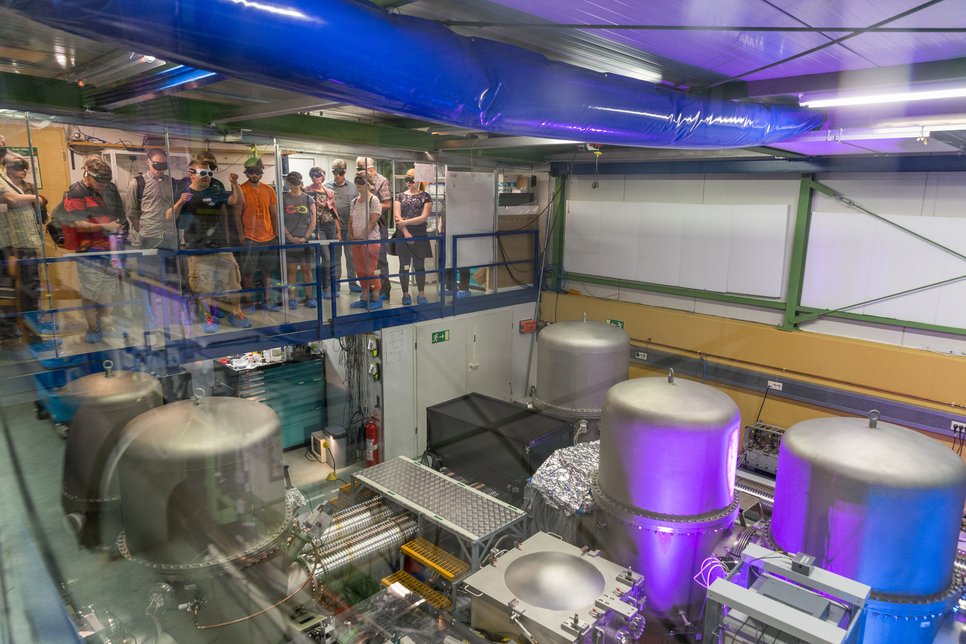Open Day at GEO600
Visit the gravitational-wave detector near Sarstedt on 30 September 2023
On Saturday, September 30, 2023, the Max Planck Institute for Gravitational Physics (Albert Einstein Institute) and the Institute for Gravitational Physics of Leibniz Universität Hannover invite you to visit the German-British gravitational-wave detector GEO600 near Sarstedt. Between 12:00 and 16:00 CEST, all visitors can speak with researchers at the detector site about the current state of gravitational-wave astronomy, the crucial contributions of GEO600 as a think tank of international research, and visit the detector.
What? Cutting-edge research up close: Open Day at the GEO600 gravitational-wave detector for all interested visitors.
When? Saturday, September 30, 2023 from 12:00 to 16:00 CEST.
Where? Ruthe near Sarstedt, directions described on the right. Come by public transport, bicycle, or car.
Prior registration is not required.
With a Nobel Prize into a new era of astronomy

The first direct observation of gravitational waves in September 2015 opened a new door to a previously hidden side of our Universe. Since then, a total of more than 90 gravitational-wave signals from merging pairs of black holes and neutron stars have been observed. A new era of astronomy has begun. In the current, fourth joint observation run “O4”, the gravitational-wave detectors have been detecting a new signal from the depths of space every two to three days since the end of May 2023.
GEO600 is instrumental in this effort as it develops and tests new technologies for gravitational-wave detection. These are critical to the sensitivity of the Virgo detector in Italy and the LIGO detectors in the US. The Nobel Prize in Physics in 2017 and other major science prizes were awarded to the international research community that operates these detectors, continually improves them and analyzes their data.
Cutting-edge research up close
At the Open Day, guests will receive first-hand information about basic research and daily work at the GEO600 gravitational-wave detector. Guided tours of the detector site with views into the heart of the highly sensitive measurement facility will be conducted as needed.
Access by public transport and bicycle
The GEO600 site is located south of the Leinemasch near the Innerste river and can be reached via a detour from the “Grüner Ring” cycle path. A visit to GEO600 can be combined with a bicycle tour. With your bike you can ride directly onto the site and up to the central building of GEO600.
By public transport you can get to the Sarstedt train station (from Hanover with the S4, the erixx and the Metronom, on weekends bicycle transport is allowed free of charge on the Greater Hanover public transport system). From there you can take a cab, continue by bike to GEO600 or take a walking tour (about 4 kilometers).
Directions from Hanover by car
Take the B6 (Messeschnellweg) south and turn right at “Sarstedt/Heisede”. Turn right to Heisede, then turn left at “Schulenburg/Ruthe”. In Ruthe turn right. After crossing the Leine River, turn right at the EXPO sign (or at the white sign “Universität Hannover/Versuchsgelände” or the green sign “Schäferberg”).
Parking
Please do not drive your car to the central building of GEO600. If you arrive by car, please use only the parking facilities at the Lehr- und Forschungsgut Ruthe of the University of Veterinary Medicine Hannover. Parking along the access roads is not permitted. From the parking lot it is a short walk of about one kilometer to the central building of the gravitational-wave observatory along the 600 meter long laser arm of GEO600.
